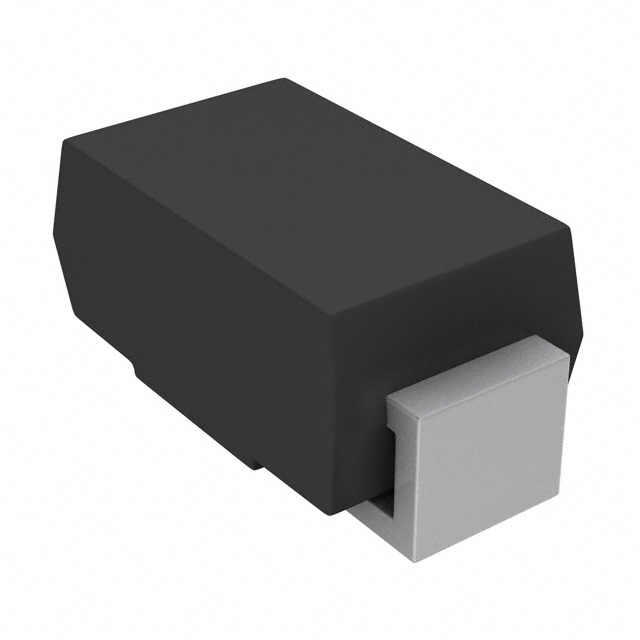Viz Specifikace pro podrobnosti o produktu.

P4SMA15A-E3/5A
Introduction
The P4SMA15A-E3/5A is a product belonging to the category of TVS (Transient Voltage Suppressor) diodes. This entry provides an overview of the basic information, specifications, detailed pin configuration, functional features, advantages and disadvantages, working principles, detailed application field plans, and alternative models of the P4SMA15A-E3/5A.
Basic Information Overview
- Category: TVS Diodes
- Use: Protection against transient voltage spikes
- Characteristics: Low clamping voltage, fast response time
- Package: DO-214AC (SMA), SMC package
- Essence: Transient voltage suppression
- Packaging/Quantity: Tape & Reel, 1800 units per reel
Specifications
- Standoff Voltage: 12.8V
- Breakdown Voltage: 14.3V
- Peak Pulse Power: 400W
- Clamping Voltage: 21.2V
- Operating Temperature: -55°C to +150°C
- Polarity: Unidirectional
Detailed Pin Configuration
The P4SMA15A-E3/5A has two pins in the SMA package, with the anode connected to the positive side and the cathode connected to the negative side.
Functional Features
- Transient Voltage Suppression: Provides protection against voltage transients by diverting excess current away from sensitive components.
- Fast Response Time: Reacts quickly to transient voltage spikes, minimizing the risk of damage to connected devices.
Advantages and Disadvantages
Advantages
- Effective protection against transient voltage spikes
- Fast response time
- Compact and easy to integrate into circuit designs
Disadvantages
- Unidirectional protection only
- Limited to specific voltage ranges
Working Principles
The P4SMA15A-E3/5A works by utilizing its low clamping voltage to shunt excess current away from sensitive components when a transient voltage spike occurs. This helps to protect downstream electronics from potential damage.
Detailed Application Field Plans
The P4SMA15A-E3/5A is commonly used in various electronic systems, including: - Power supplies - Communication equipment - Industrial control systems - Automotive electronics - Consumer electronics
Detailed and Complete Alternative Models
Some alternative models to the P4SMA15A-E3/5A include: - P4SMA6.8A-E3/61 - P4SMA10A-E3/61 - P4SMA13A-E3/61 - P4SMA16A-E3/61
In conclusion, the P4SMA15A-E3/5A is a TVS diode that offers effective protection against transient voltage spikes, making it an essential component in various electronic systems.
(Word count: 410)
Seznam 10 běžných otázek a odpovědí souvisejících s aplikací P4SMA15A-E3/5A v technických řešeních
What is the maximum peak pulse power of P4SMA15A-E3/5A?
- The maximum peak pulse power is 400 watts for a 10/1000μs waveform.
What is the breakdown voltage of P4SMA15A-E3/5A?
- The breakdown voltage is typically 16.7V at 1mA.
What are the typical applications for P4SMA15A-E3/5A?
- P4SMA15A-E3/5A is commonly used in surge protection for sensitive electronics, such as in telecommunications equipment, industrial control systems, and automotive electronics.
What is the clamping voltage of P4SMA15A-E3/5A?
- The clamping voltage is typically 24.4V at 34.8A.
What is the operating temperature range of P4SMA15A-E3/5A?
- The operating temperature range is -55°C to +150°C.
Is P4SMA15A-E3/5A RoHS compliant?
- Yes, P4SMA15A-E3/5A is RoHS compliant.
What is the package type of P4SMA15A-E3/5A?
- P4SMA15A-E3/5A is available in a DO-214AC (SMA) package.
Does P4SMA15A-E3/5A have lead-free terminations?
- Yes, P4SMA15A-E3/5A has lead-free terminations.
What is the reverse stand-off voltage of P4SMA15A-E3/5A?
- The reverse stand-off voltage is 15V.
Are there any recommended layout guidelines for using P4SMA15A-E3/5A in a circuit?
- Yes, it is recommended to follow the layout guidelines provided in the datasheet to ensure optimal performance and reliability.

